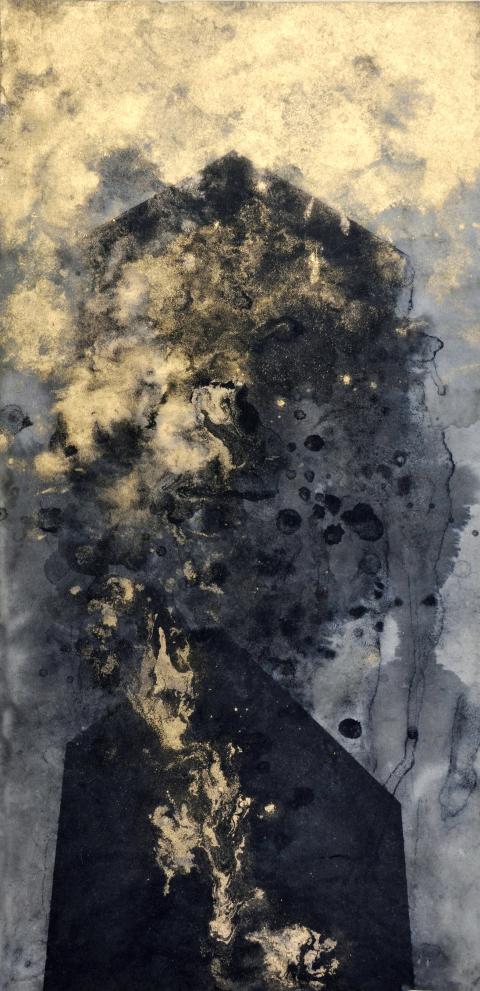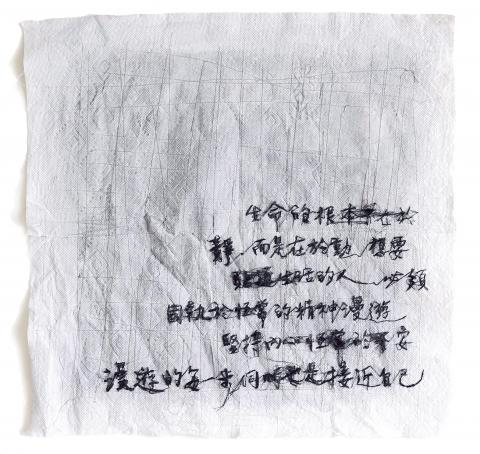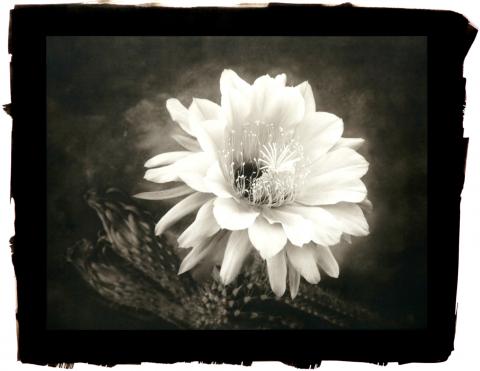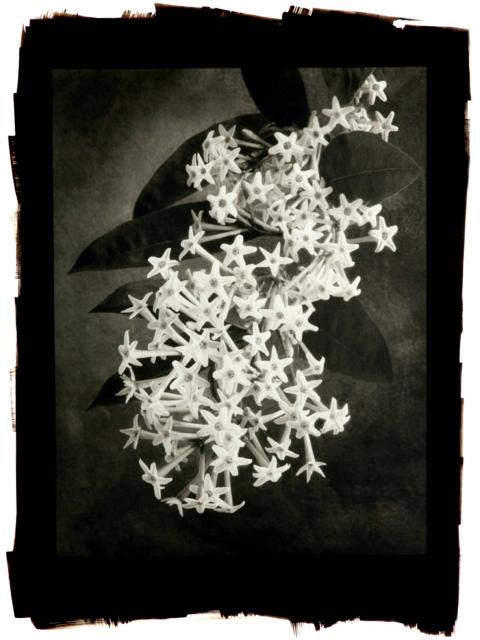Kalos Gallery in Taipei will have two exhibitions running side by side tomorrow, both of which explore the relationship between art and writing, fact and fiction. Childhood (童年), an exhibition by Chen Che-wei (陳哲偉), tells a tumultuous story of an imaginary family from a different era through a series of fake photo albums, heirlooms and other objects. The effect is haunting as the images appear to be genuine. On the other hand, Liu Feng-ling (劉鳳鴒) examines the ideas of linearity and subtexts in Penetrate (滲). She does this through using the text from letters her father wrote and books she read while growing up. Liu creates sort of a diary through knitting words on napkins, giving it a rather homely feel. But the chronology is jumbled up and her impressions of what took place in the past are also interfused with the rest of the text. Writing and photography are often thought to be an accurate means of recording the past, but as both artists demonstrate, the process is not as straightforward as it seems.
■ Kalos Gallery (真善美畫廊), 269, Dunhua S Rd Sec 1, Taipei City (台北市敦化南路一段269號), tel: (02) 2836-3452. Open daily from 10am to 6:30pm
■ Both exhibitions open tomorrow and are until Aug. 15

Photo courtesy of A Gallery
Exhibitions at quirky hipster cafes seems to be the rage this summer. Cafe Vergissmeinnicht recently had one, as did Lili Gallery Bar & Restaurant. And now, P Cafe in New Taipei City’s Tamsui District (淡水) is currently hosting Meditation (默思), a solo exhibition by Ji Lun-qi (紀倫棋). Consisting of a series of black-and-white photographs where the subject is usually a person doing something odd and bizarre — hammering nails into their palms or being strung from their heads from clothes hangers — Ji intends to make his viewers think hard since part of the fun is figuring out what the heck is going on. Nowadays, anyone with a smartphone and Instagram can be a so-called photographer — just snap a picture, choose a pretty filter and upload. In reality, a real photographer must not only grasp the technicalities like lens and angles, but more importantly, know how to tell a story.
■ P Cafe, 2F, 180, Zhongzheng Rd, New Taipei City (新北市中正路180號2樓), tel: (02) 2626-3866. Open Tuesdays to Sundays from 11am to 9pm
■ Until Aug. 21

Photo courtesy of Kalos Gallery
The loneliness of big city life is an oft-explored theme in modern art — so much so that it’s become quite trite. However, Chang Yi-sheng (張益昇) takes a refreshingly abstract approach to the theme, his textured clouds of golden-grayish hues creating an effect that is at once intoxicating as well as stifling. The gold ink in his paintings, while lustrous, also has a feeling of dignified calmness, as if Chang were trying to carve out a space of solitude amid the black-and-gray smog-like movements. People who live in big cities move there for a reason, usually to fulfill a dream like bettering your career. Chang’s message is not so much that dreams are easily crushed — rather, it’s more that case that you need to figure out a way to stand out from the crowd. Only then will it be easier to realize whatever lofty goals you have. Chang’s paintings are currently on display at Taipei’s A Gallery in an exhibition entitled The Bustling Dream (繁華攏是夢).
■ A Gallery (當代一畫廊), 22, Alley 36, Lane 147, Xinyi Rd Sec 3, Taipei City (台北市信義路三段147巷36弄22號), tel: (02) 2702-3327. Open Mondays to Saturdays from 10am to 6pm
■ Until Aug. 22

Photo courtesy of 1839 Contemporary Gallery
Outspoken artists James T Hong (洪子健) and Chen Yin-ju (陳瀅如), both of whose videos often serve the purpose of functioning as social critique, are collaborating yet again on another mind-prickling project. Held at The Cube Project Space, The Starry Heavens Above and the Moral Law Within (上則星辰,內則德律) explores our relationship with drugs from ancient times to the present day. Utilizing historical documents, paintings and videos, the exhibition starts with the pre-modern era where psychotropic plants were used in religious ceremonies. It then covers the Opium Wars in the mid-1800s, a time when drugs came to be industrially produced rather than plucked from nature. The exhibition touches on drug trafficking and abuse, as is the counter idea that doing drugs is actually a way to express one’s freedom and rebel against the state. Who knew that so much could be learned about the evolution of societies and cultures through analyzing the ways that people throughout time got high?
■ The Cube Project Space (立方計畫空間), 2F, 13, Alley 1, Ln 136, Roosevelt Rd Sec 4, Taipei City (台北市羅斯福路四段136巷1弄13號2樓), tel: (02) 2368-9418. Open Wednesday to Sunday from 2pm to 8pm
■ Until Oct. 4

Photo courtesy of 1839 Contemporary Gallery
Flowers are a popular motif among artists. But rather than accentuating their vibrant and lively colors, American photographer Cy DeCosse chooses to shoot in black and white. Utilizing platinum printing — an old method of monochrome printing from the 19th century that produces a wide tonal range — the details of each flower are eerily visible, from the curvature of a petal to the prick on a cactus. Like most photographers who today shoot in black and white, DeCosse’s choice is not coincidental. Although they are beautiful, flowers have a short life span, and the darkness in DeCosse’s photographs seems to symbolize the idea of imminent death. Flowers also bloom at night – when people are sleeping — so their true beauty is, for the most part hidden from us. DeCosse’s prints are on display at Taipei’s 1839 Contemporary Gallery, in an exhibition entitled International Photography Platinum Series (佰年攝影史—白金攝影).
■ 1839 Contemporary Gallery (當代藝廊), B1, 120 Yanji St, Taipei City (台北市延吉街120號B1), tel: (02) 2778-8458. Open Tuesdays to Sundays from 11am to 8pm
■ Until Aug. 16

Every now and then, it’s nice to just point somewhere on a map and head out with no plan. In Taiwan, where convenience reigns, food options are plentiful and people are generally friendly and helpful, this type of trip is that much easier to pull off. One day last November, a spur-of-the-moment day hike in the hills of Chiayi County turned into a surprisingly memorable experience that impressed on me once again how fortunate we all are to call this island home. The scenery I walked through that day — a mix of forest and farms reaching up into the clouds

With one week left until election day, the drama is high in the race for the Chinese Nationalist Party (KMT) chair. The race is still potentially wide open between the three frontrunners. The most accurate poll is done by Apollo Survey & Research Co (艾普羅民調公司), which was conducted a week and a half ago with two-thirds of the respondents party members, who are the only ones eligible to vote. For details on the candidates, check the Oct. 4 edition of this column, “A look at the KMT chair candidates” on page 12. The popular frontrunner was 56-year-old Cheng Li-wun (鄭麗文)

“How China Threatens to Force Taiwan Into a Total Blackout” screamed a Wall Street Journal (WSJ) headline last week, yet another of the endless clickbait examples of the energy threat via blockade that doesn’t exist. Since the headline is recycled, I will recycle the rebuttal: once industrial power demand collapses (there’s a blockade so trade is gone, remember?) “a handful of shops and factories could run for months on coal and renewables, as Ko Yun-ling (柯昀伶) and Chao Chia-wei (趙家緯) pointed out in a piece at Taiwan Insight earlier this year.” Sadly, the existence of these facts will not stop the

Oct. 13 to Oct. 19 When ordered to resign from her teaching position in June 1928 due to her husband’s anti-colonial activities, Lin Shih-hao (林氏好) refused to back down. The next day, she still showed up at Tainan Second Preschool, where she was warned that she would be fired if she didn’t comply. Lin continued to ignore the orders and was eventually let go without severance — even losing her pay for that month. Rather than despairing, she found a non-government job and even joined her husband Lu Ping-ting’s (盧丙丁) non-violent resistance and labor rights movements. When the government’s 1931 crackdown